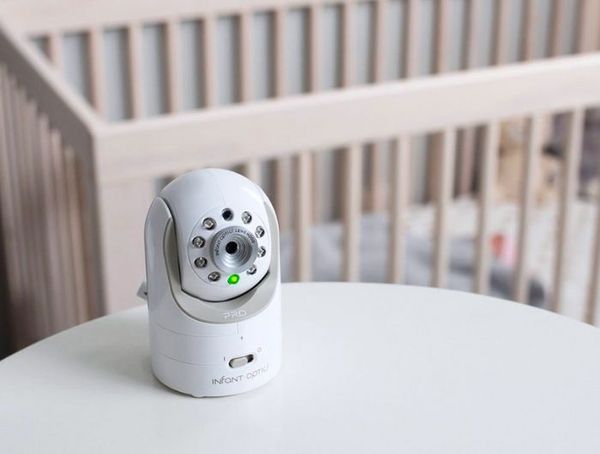Have you wondered if your baby monitor is vulnerable to hacking and security vulnerabilities, and what you can do to prevent it. In this blog post, we will answer these questions and give you some tips on how to secure your baby monitor from unauthorized access.
What is a WiFi Baby Monitor and How Does It Work?
A WiFi baby monitor is a device that uses wireless signals to transmit video and audio data from a camera in your baby's room to your smartphone or tablet. You can use an app on your device to see and hear what is happening in your baby's room, and sometimes even talk to your baby or control the camera.
This kind of monitor works by connecting to your home WiFi network and the internet. This allows you to access your baby monitor from anywhere in the world via an internet connection. However, this also means that anyone who has access to your WiFi network or the internet can potentially hack into your baby monitor and see or hear what is happening in your baby's room.
Can WiFi Baby Monitors Be Hacked?
The short answer is yes, WiFi baby monitors can be hacked. They are vulnerable to hacking because they are internet connected devices that use wireless signals to communicate. Wireless signals can be intercepted or jammed by hackers who have the right tools and skills. Internet connected baby monitors can also be hacked by hackers who can exploit their security flaws or weaknesses.
This means that anyone who has access to your wifi network or the internet can potentially hack into your baby monitor and see or hear what is happening in your baby's room. This can be very disturbing and dangerous, especially if the hacker tries to talk to your baby or control the camera.
Common ways of baby monitor hacking:
Guessing or finding the default password and username of the baby monitor
Many WiFi monitors come with a default password and username that are easy to guess or find online. Hackers can use these credentials to access your baby monitor without your knowledge.
Scanning the internet for open camera access ports of baby monitors
Some baby monitors use a default camera access port which is common for many devices. This makes it easier for hackers to scan the internet for vulnerable baby monitors and access them.
Joining your WiFi network or using public WiFi networks or hotspots
If your WiFi network is not encrypted or protected by a strong password, anyone can join it and hack into your baby monitor or other smart devices. Similarly, if you use public WiFi networks or hotspots when accessing your baby monitor, hackers can intercept or modify your data.
Exploiting bugs or vulnerabilities in the baby monitor firmware or app
Baby monitors are constantly evolving and improving baby monitor security. However, this also means that they may have bugs or vulnerabilities that hackers can exploit. Hackers can use these bugs or vulnerabilities to gain access to your baby monitor or control it remotely.
How to Secure Your WiFi Baby Monitor?
Fortunately, there are some steps you can take to protect your baby monitor from being hacked. Here are some of them:
Use Digital Baby Monitors Instead of Analog
An analog baby monitor transmits its signals over radio waves, which can easily be intercepted by anyone with the right equipment. Digital baby monitors, on the other hand, use encrypted signals that are much more difficult for hackers to access. So, if you're in the market for a new baby monitor, consider choosing a digital model to improve your baby monitor security.
Change the Default Password and Username
One of the easiest and most effective ways to secure your baby monitor is to change the default password and username to something unique and strong that only you know. You should also change them regularly and avoid using the same password for different accounts or devices.
Avoid using easily guessable information like your child's name or birthdate, and opt for a combination of letters, numbers, and special characters.
To change the default password and username of your baby monitor, you need to access its settings through its app or web interface. You can find the instructions on how to do this in the user manual of your baby monitor or on the manufacturer's website.
Disable Remote Access If You Don't Need It
Some baby monitors allow you to access them remotely from anywhere in the world via the internet. This can be convenient if you want to check on your baby while you are away from home, but it also increases the risk of hacking.
If you don't need this feature, you should disable it in the settings of your baby monitor or app. This will limit the access to your baby monitor to only those devices that are connected to your home WiFi network.
Change the Default Camera Access Port If Possible
Many WiFi baby monitors come with a default camera access port, which can make it easier for hackers to gain access to your device. To prevent unauthorized incoming traffic, change the default port number to something unique and more difficult for hackers to guess.
You can find the instructions on how to do this in the user manual of your baby monitor or on the manufacturer's website.
Use a Secure WiFi Network
Your baby monitor is only as secure as your WiFi network. If your WiFi network is not encrypted or protected by a strong password, anyone can join it and hack into your baby monitor or other smart devices.
To prevent this, you should use a secure WiFi network that has WPA2 encryption and a strong password that is not shared with anyone else. You should also avoid using public WiFi networks or hotspots when accessing your baby monitor.
Use a Firewall or Network Address Translation (NAT)
A firewall or NAT is a device or software that blocks unauthorized incoming traffic from the internet to your home network. By enabling NAT on your router, you can help protect your baby monitor from unauthorized incoming traffic, making it more difficult for hackers to gain access to your baby monitor or other smart devices.
You can use a firewall or NAT that is built into your router or modem, or install one on your computer or smartphone. You can find more information on how to set up a firewall or NAT on the internet or consult an expert if you need help.
Set Up Port Forwarding
Port forwarding is a security feature that allows you to specify which devices on your network can accept incoming connections. By setting up port forwarding for your baby monitor, you can help prevent baby monitor hacking by only allowing specific, trusted devices to connect.
Update Your WiFi Baby Monitor Firmware and App Regularly
Baby monitors are constantly evolving and improving their features and security. However, this also means that they may have bugs or vulnerabilities that hackers can exploit.
To avoid this, you should update your baby monitor firmware and app regularly whenever there is a new version available. This will ensure that you have the latest security patches and fixes for your baby monitor.
You can check for updates in the settings of your baby monitor app or on the manufacturer's website. You should also enable automatic updates if possible.
Conclusion
While the risk of baby monitor hacking is real, there are steps you can take to improve your baby monitor security and protect your little one. By following the tips outlined in this blog post, you can feel more confident in the safety of your WiFi baby monitor and focus on what really matters – enjoying precious moments with your child.
Thank you for reading Mother Bear Reviews, your favorite parenting blog!









